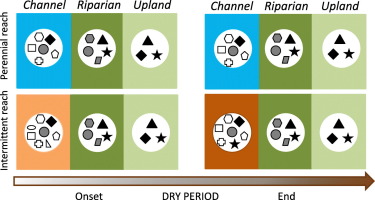当前位置:
X-MOL 学术
›
Biol. Conserv.
›
论文详情
Our official English website, www.x-mol.net, welcomes your
feedback! (Note: you will need to create a separate account there.)
Dynamics of ground-dwelling arthropod metacommunities in intermittent streams: The key role of dry riverbeds
Biological Conservation ( IF 4.9 ) Pub Date : 2020-01-01 , DOI: 10.1016/j.biocon.2019.108328 María Mar Sánchez-Montoya , Klement Tockner , Daniel von Schiller , Jesús Miñano , Chema Catarineu , Jose L. Lencina , Gonzalo G. Barberá , Albert Ruhi
Biological Conservation ( IF 4.9 ) Pub Date : 2020-01-01 , DOI: 10.1016/j.biocon.2019.108328 María Mar Sánchez-Montoya , Klement Tockner , Daniel von Schiller , Jesús Miñano , Chema Catarineu , Jose L. Lencina , Gonzalo G. Barberá , Albert Ruhi

|
Abstract Intermittent streams are subject to high levels of environmental variation. However, little is known about how biota responds to river drying across the channel-to-upland habitat gradient. This is an important shortcoming because assumes that intermittent river habitats and metacommunities are static. Here we studied how river drying affects the spatial and temporal variation in ground-dwelling arthropod communities (spiders, beetles, and ants) across the lateral habitat gradient. We asked whether particular habitats, moments, or species contribute disproportionally to beta diversity. To this end, we monitored two perennial-intermittent reach pairs during an entire drying cycle, and applied beta-diversity partitioning methods to highly-resolved taxonomy data. We predicted that: (i) intermittent reaches would accumulate higher levels of diversity (alpha and beta) than perennial reaches; (ii) dry riverbeds would harbor more species and more unique species; (iii) alpha and beta diversity would be temporally more variable in intermittent than in permanent reaches; and (iv) species dispersal limitation would explain variation in contributions to beta diversity. Intermittent reaches presented higher alpha and beta diversity, with dry channels harboring more unique species and more species than any other habitat. Arthropod metacommunities were more variable across space than over time, and temporal turnover was significant—with species dispersal limitation being positively associated with contributions to beta diversity. Our results elevate the role of dry channels in intermittent river ecology, and show that previous research has likely underestimated their contributions to river-wide biodiversity. Our findings call for the need to integrate the dry phase of intermittent streams into monitoring and conservation programs.
中文翻译:

间歇性溪流中地栖节肢动物群落的动态:干涸河床的关键作用
摘要 间歇性溪流易受高度环境变化的影响。然而,关于生物群如何响应跨河道到高地栖息地梯度的河流干涸知之甚少。这是一个重要的缺点,因为假设间歇性河流栖息地和元群落是静态的。在这里,我们研究了河流干涸如何影响横向栖息地梯度的地栖节肢动物群落(蜘蛛、甲虫和蚂蚁)的空间和时间变化。我们询问特定栖息地、时刻或物种是否对 Beta 多样性的贡献不成比例。为此,我们在整个干燥周期中监测了两个多年生间歇性河段对,并将 beta 多样性划分方法应用于高分辨率分类数据。我们预测:(i) 间歇性河段比常年河段积累更高水平的多样性(阿尔法和贝塔);(ii) 干涸的河床将容纳更多物种和更多独特物种;(iii) alpha 和 beta 多样性在间歇性比在永久性河段中在时间上的变化更大;(iv) 物种扩散限制可以解释对 beta 多样性的贡献的变化。间歇性河段呈现出更高的 alpha 和 beta 多样性,干河道比任何其他栖息地拥有更多独特的物种和更多的物种。节肢动物元群落在空间上的变化多于时间,并且时间更替很重要——物种扩散限制与对β多样性的贡献呈正相关。我们的研究结果提升了干河道在间歇性河流生态中的作用,并表明之前的研究可能低估了它们对河流生物多样性的贡献。我们的研究结果呼吁需要将间歇性河流的干燥阶段纳入监测和保护计划。
更新日期:2020-01-01
中文翻译:

间歇性溪流中地栖节肢动物群落的动态:干涸河床的关键作用
摘要 间歇性溪流易受高度环境变化的影响。然而,关于生物群如何响应跨河道到高地栖息地梯度的河流干涸知之甚少。这是一个重要的缺点,因为假设间歇性河流栖息地和元群落是静态的。在这里,我们研究了河流干涸如何影响横向栖息地梯度的地栖节肢动物群落(蜘蛛、甲虫和蚂蚁)的空间和时间变化。我们询问特定栖息地、时刻或物种是否对 Beta 多样性的贡献不成比例。为此,我们在整个干燥周期中监测了两个多年生间歇性河段对,并将 beta 多样性划分方法应用于高分辨率分类数据。我们预测:(i) 间歇性河段比常年河段积累更高水平的多样性(阿尔法和贝塔);(ii) 干涸的河床将容纳更多物种和更多独特物种;(iii) alpha 和 beta 多样性在间歇性比在永久性河段中在时间上的变化更大;(iv) 物种扩散限制可以解释对 beta 多样性的贡献的变化。间歇性河段呈现出更高的 alpha 和 beta 多样性,干河道比任何其他栖息地拥有更多独特的物种和更多的物种。节肢动物元群落在空间上的变化多于时间,并且时间更替很重要——物种扩散限制与对β多样性的贡献呈正相关。我们的研究结果提升了干河道在间歇性河流生态中的作用,并表明之前的研究可能低估了它们对河流生物多样性的贡献。我们的研究结果呼吁需要将间歇性河流的干燥阶段纳入监测和保护计划。











































 京公网安备 11010802027423号
京公网安备 11010802027423号